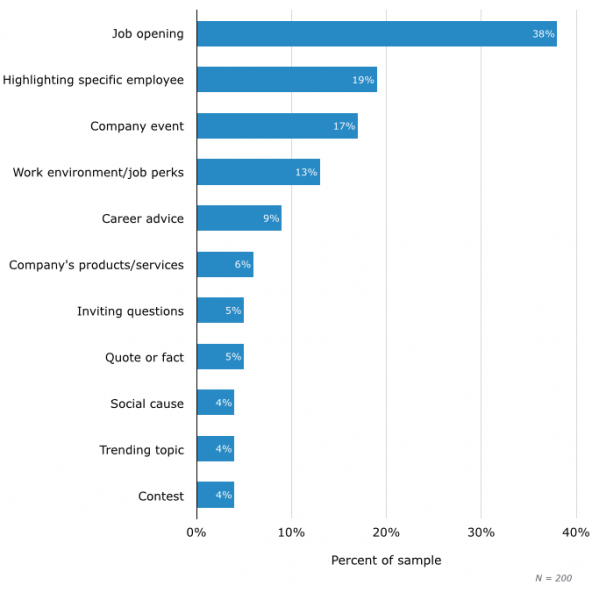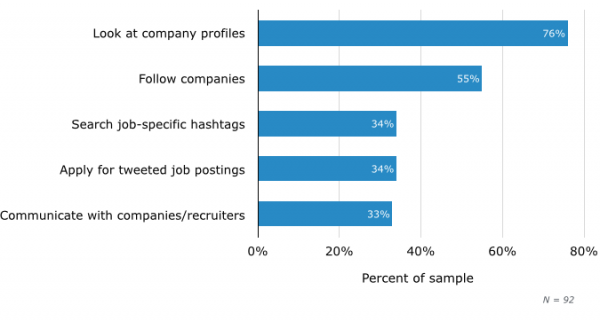Twitter Is Great for Sourcing — Just Don’t Treat It Like a Job Board

But Brian Westfall, market research associate at Software Advice and the author of the study in question, takes a more optimistic approach to these numbers.
“I was actually surprised by how many Fortune 500 companies had a specific Twitter handle for recruiting,” Westfall says. “One hundred seventy-four of the 500 companies have Twitter handles specific to recruiting.”
Put in those terms, the situation does seem a bit more encouraging: maybe it’s just the fact that “174” looks a lot bigger than “35 percent,” but the real point is this: Twitter is a great recruiting platform, provided recruiters know how to properly leverage it.
“Looking at Twitter demographics, it’s a growing user base, and it’s a growing user base that is important for recruiting,” Westfall says.

Most Common Subjects of Fortune 500 Tweets. Courtesy of Software Advice.
According to the Pew Research Center, Twitter has seen significant growth in users from important talent demographics, including college graduates, urbanites, and people with annual household incomes over $50,000.
“That covers a broad group of employees that companies are looking for,” Westfall says. “It’s obvious that the audience is there — there’s just a disconnect between how companies are using Twitter, and how companies are interacting with job seekers.”
Twitter Is Not a Job Board — Think of It as a Content Marketing Platform Instead
The “disconnect” Westfall mentions refers to the fact that many companies who do have recruiting-specific Twitter handles use these handles to simply post job openings and little — or nothing — else. Indeed, job openings account for 38 percent of the tweets sent from recruiting-specific Fortune 500 Twitter handles — a greater percentage than any other category of tweet (e.g., career advice [9 percent], highlighting employees [19 percent], and mentions of workplace environments and/or perks [13 percent]).
The problem with treating Twitter like a job board, rather than a content marketing platform, is that doing so doesn’t exactly capture the attention of potential candidates.
“If you had a Twitter handle [that] faced customers, you wouldn’t just have a bland automated post every day about a new item that you have on sale,” Westfall says. “That’s not going to interest anybody — so why would you do that with job seekers?”
That’s not to say that employers shouldn’t use their recruiting-specific Twitter handles to post job openings — just that job openings shouldn’t be the only thing they post. Westfall suggests sharing more content that will engage potential candidates, including things like:
- videos of employees talking about why they love working for the company;
- information about interesting company events;
- discussions of workplace perks;
- and tweets related to social causes about which the company feels strongly.
To successfully recruit talent via Twitter, employers should focus more on marketing their companies as great places to work, and a little less on throwing contextless job openings at their followers.

Most Common Ways Job Seekers Use Twitter. Courtesy of Software Advice.
“I think it’s important that recruiters not get hasty and think they’re going to get a bunch of applicants right off the bat when they tweet a job opening,” Westfall says. “[Twitter] is more of a curation process. It’s about getting people hooked, getting them engaged, and getting them to follow you. When the time comes that they’re looking for a job, then they’ll apply, and I think Twitter is really great for that.”
It’s also important for employers and recruiters to make sure they use separate, distinct Twitter handles specifically for their recruiting efforts. A company’s customers may not necessarily be the same kinds of people whom the company wants to recruit, making it difficult to speak to both these audiences from the same Twitter handle. Westfall recommends that, when it comes to interacting with customers and possible recruits, employers and recruiters “keep ’em separated.” (Potentially NSFW, depending on how your office feels about The Offspring.)
Who Should Use Twitter to Recruit Talent?
“That depends on the industry the company is in and what type of worker [it’s] looking for,” Westfall says. “If the Twitter demographics closely match the type of worker you’re looking for, the type of expertise you’re looking for, than [Twitter] is going to be a great fit. But it really is just going to depend.”
For example, Westfall recalls speaking with a source who told him that a lot of IT people are on Twitter, but not LinkedIn.
“You might think that all job seekers go to LinkedIn, but maybe in [some cases], they’re not there — they’re on Twitter,” he says.
As with any recruiting channel, recruiters need to ask themselves a couple of questions before they decide to leverage Twitter as a sourcing tool: where are the job seekers that I’m looking for hanging out online, and how can I best curate content to attract them?

